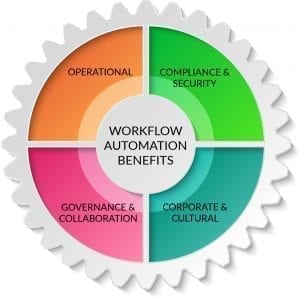How to Create a Paperless Workflow (and Why!)
There are huge benefits in using a paperless workflow in place of a paper-driven process. Unless, that is, you’re fond of paper cuts, stapler accidents, and desperate document searches through dusty drawers?
According to a 2020 study by Gartner, a whopping 91% of organizations are engaged in some form of digital initiative. Why? Because it just makes sense. Even before the pandemic introduced us to hybrid work environments, paper-heavy processes presented a myriad of challenges to companies.
First and foremost? Relying on paper is expensive. First, there’s the cost of the paper itself (not to mention the environmental impact it has), and then there’s the physical storage requirements of that paper.
You also need to take into account the fact that it makes your employees less efficient and lowers productivity. Not only does it slow them down, it creates more room for error, which drives greater risk.
Let’s take a deeper look at why your organization should consider going paperless, if it isn’t there already.
The benefits of going paperless
Cost reduction
Space is always a challenge for any organization – physical storage costs are a major expense for most. From paper costs to printers, hardware, office supplies, to shipping and mailing costs, going paperless can save you a surprising amount of money that you haven’t even considered when mapping out your budget.
Electronic storage is the answer. You save storage space and save money on all of the above, as well as operation costs and time that is otherwise wasted hunting for a particular document through a confusing paper trail.
Especially now, with the COVID-19 pandemic causing changes in the physical workplace, it can add unnecessary complexity to have files stored in physical form. With your employees potentially working from home or splitting their time between the office and remote work, it’s crucial that they all have equal access to the necessary resources and documents they require.
As an article by Forbes points out:
“We’ve been talking about the paperless office literally for decades, but the average office worker still uses some 10,000 sheets of paper a year. According to The Paperless Project (via Medium), American corporations ‘spend over $120 billion on printed forms, most of which become outdated within three months.'”
Better collaboration & error reduction
The less you have humans handling your workflows, the less likely you are to encounter human error, naturally. With paper-based processes, specifically, the opportunity for human error is pretty high; this can involve anything from incomplete forms to illegible handwriting.
As trivial as they may seem at the time (and the mistakes may be easily and innocently made), these errors can disrupt your workflows. That can cause employees to blame each other, fueling resentment or just causing unhappy staffers.
By going paperless, you’re more likely to find fault with the workflow itself, rather than team members, and focus on how to improve the process for better performance in the future. This leads to less human error and better collaboration and improved morale among employees and teams.
Improved security & compliance
As with digitizing any workflow or process, when you move your documents to a cloud-based paperless system, you enhance security measures against physical threats. From theft to natural disasters such as fires or floods, it’s easy to lose crucial data that is stored in paper form – once you have that data backed up, you’re far better prepared for threats with data recovery options.
Once you transition from mountains of incomplete or missing paperwork to digital paper trails, auditing your processes becomes a lot easier and quicker. A digital record of documents means greater transparency and visibility, making it easier to make sure you’re in compliance with all necessary industry and government regulations.

Steps to implement a paperless workflow model
Here are the basics in how to evolve – and really, that’s the right word for it – from paper-driven processes to paperless office workflows:
- Establish procedures for document management: This is fundamental, and should involve key stakeholders in its development, and has to take place before you digitize anything.
- Decide where data will be stored: In the cloud? In on-premise servers? Not on employee devices or in other silos where they may be inaccessible — and insecure.
- Leverage automation: It’s a given that you’ll digitize these processes, but without an automated document workflow solution, you’ll find a digital process can be just as time-consuming and problematic as a paper-based one.
- Back up all digitized documents: Make sure you find a secure centralized repository for them, and follow a digital taxonomy that makes sense for the organization.
- Notify clients of document destruction policies: Let them know that hard copies are becoming a thing of the past, and let them know your policy for transitioning and storing these files or documents.
[bctt tweet=”Almost half of all printed documents are tossed within 24 hours, and 30% are never picked up from the printer at all. ” via=”no”]
Use best-in-class tools to facilitate paperless workflows
What does a paperless workflow look like? There’s no one-template-fits-all answer. Because the first step to creating a paperless workflow is to decide which workflow you want to digitize.
Try to start with a widely used workflow that follows the same set of processes and is repeated frequently. An example might be new hire onboarding. Streamlining this process can save your HR department untold hours of valuable time, and it helps your new employees get ready for their roles in the most efficient way possible.
By automating a workflow that’s used a lot, you can quickly see ROI. While demonstrating the benefits of a paperless workflow early for others within the organization, too.
Another good starting point you may want to consider as you go paperless is incorporating electronic signatures to your processes. It’s a simple way of indicating consent or approval on your digital documents, and it’s legally acceptable. It’s a secure, convenient way to let you sign documents online from anywhere, e-signature software has the power to speed agreement processes and maximize productivity across your organization.
Confused about where to begin? Mitratech offers TAP Workflow Automation as an easy-to-implement solution. It offers full integration with the most advanced and secure e-signature platforms around. As you begin to go paperless, you can rest easy knowing your forms and contracts are compliant, legally binding, and secure.


